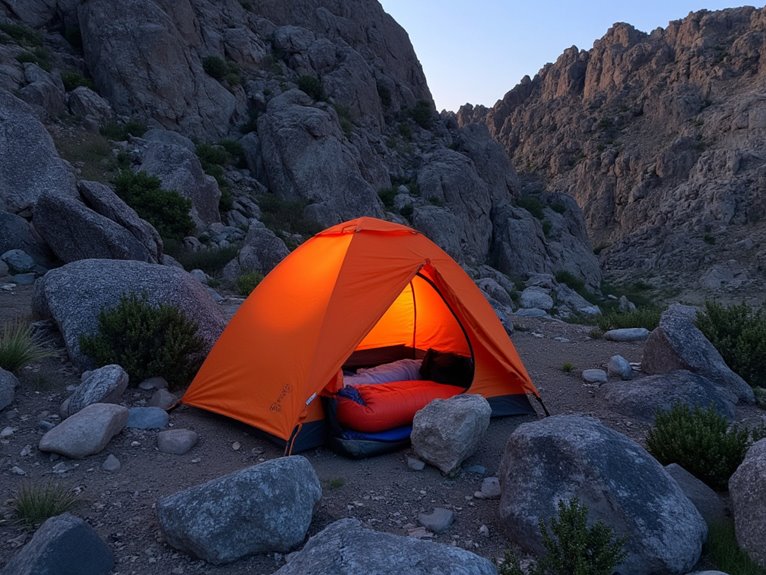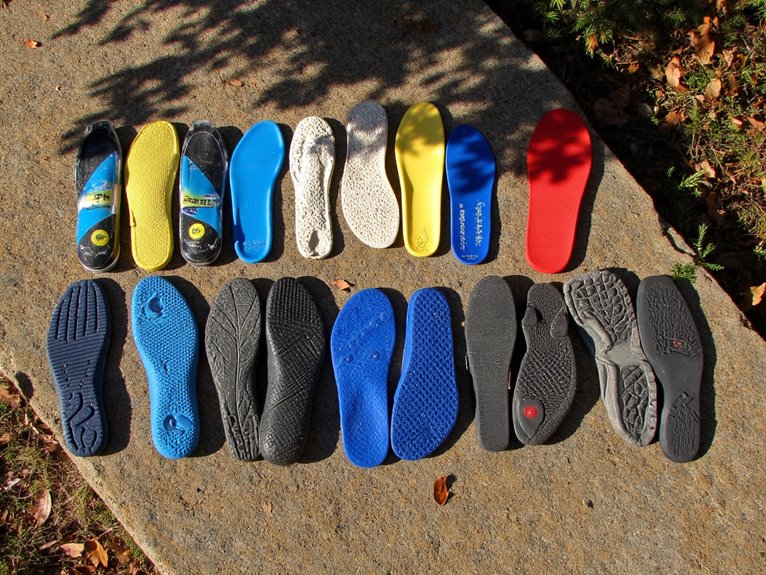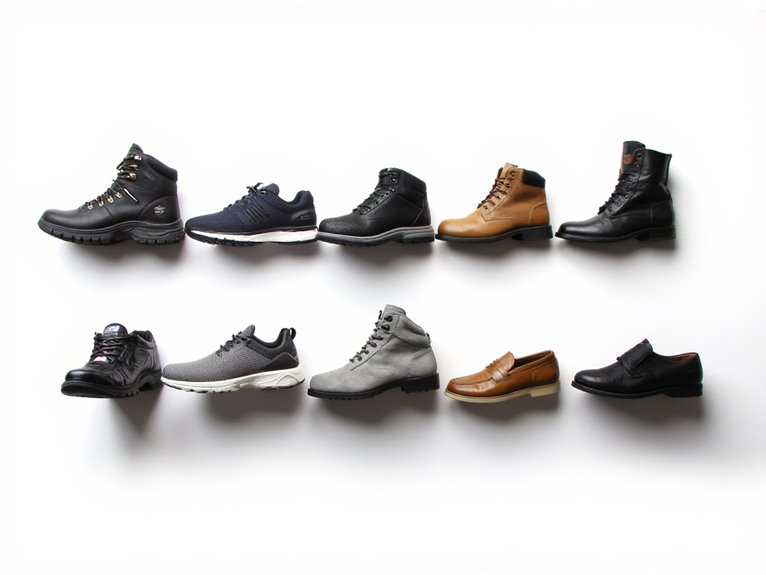How to Sleep on Uneven or Rocky Ground
To sleep comfortably on uneven or rocky ground, you’ll need to systematically clear debris larger than golf balls and check for overhead hazards like loose branches. Position your tent entrance uphill and use padding materials to level the downhill side under your sleeping pad. Select a sleeping pad with an R-value of 4 or higher for proper insulation, and place it parallel to slopes to prevent sliding. The techniques below will help you master advanced ground preparation methods.
We are supported by our audience. When you purchase through links on our site, we may earn an affiliate commission, at no extra cost for you. Learn more. Last update on 10th December 2025 / Images from Amazon Product Advertising API.
Notable Insights
- Clear rocks larger than golf balls and sharp debris, then use the snow angel method to detect hidden obstacles.
- Position your sleeping pad parallel to slopes and pad the downhill side to prevent sliding and level the surface.
- Choose a sleeping pad with R-value 4+ for insulation and avoid overinflating to maintain ground contour conformance.
- Face tent entrance uphill and adjust guyline lengths based on terrain features for optimal setup stability.
- Consider alternative solutions like hammocks, cots, or rooftop tents to eliminate direct contact with rocky ground.
Evaluating Terrain and Selecting Your Campsite
Five critical factors determine whether you’ll wake up refreshed or spend the night tossing on uncomfortable terrain.
During your terrain assessment, prioritize soil stability by checking for erosion signs, loose rocks, or exposed tree roots. Press the ground with your hands to detect hidden stones beneath the surface. Your campsite location should feature flat areas with intact vegetation rather than bare mineral soil or waterlogged depressions that collect rainwater.
Surface material directly impacts comfort levels. Grass and sand provide superior insulation and cushioning compared to hard rock surfaces or leafy forest floors. Avoid muddy areas prone to flooding.
Select sheltered positions behind natural windbreaks like rocks or trees while maintaining distance from water sources to prevent pollution.
Look for established sites before creating new impact zones to minimize ecological damage.
For rocky terrain, consider how your gear choice affects comfort, as sleeping pads offer better puncture resistance than air mattresses when dealing with sharp ground surfaces.
Clearing and Preparing the Sleeping Area
After identifying your ideal campsite, you’ll need to transform the raw terrain into a comfortable sleeping surface through systematic clearing and preparation.
Begin debris removal by extracting rocks larger than golf balls and sharp objects that could puncture tent fabric. Sweep away twigs, pinecones, and leaves using broad arm motions.
Check overhead for widow-makers—loose branches that pose falling hazards. Flatten visible bumps by pressing down with hands or feet.
Conduct thorough insect checks by examining the ground for ant hills, wasp nests, or animal burrows within a three-foot radius.
Use the snow angel method: lie down and move your limbs to detect hidden rocks. Fill depressions with natural materials like leaves or pine needles, creating a level foundation for peak sleep quality.
Place a ground cloth beneath your sleeping area to prevent moisture transfer and provide an additional protective barrier between you and the terrain.
Strategic Tent Positioning and Setup
Always face the entrance uphill to prevent gear loss during exit.
When pitching perpendicular, pad the downhill side under your sleeping pad using clothing or gear to level the surface.
Adjust guyline lengths based on terrain—use shorter cords on higher spots and longer ones in dips.
Set the highest corner cord to zero length for the lowest possible pitch, accepting gaps under 5 centimeters.
Arranging Your Sleep System for Maximum Comfort
Once you’ve positioned your tent correctly on uneven terrain, your sleep system becomes the determining factor between a restless night and quality recovery. Select a sleeping pad with an R-value of 4 or higher for cold ground insulation.
Position the pad parallel to slopes to prevent sliding and maximize surface contact. Proper sleep posture requires selective padding beneath pressure points like shoulders and hips.
Essential gear adjustments include stuffing clothing under your feet to prevent downhill sliding and wedging rolled garments beneath the pad at hip level. Test your positioning before settling in.
For backpacking trips where weight is critical, choose a mummy-style bag under 3 pounds that compresses efficiently while providing adequate warmth for the expected ground temperature conditions.
- Use high-quality ground sheets for moisture protection and additional insulation
- Layer sleeping pads or clothing for extra cushioning against protruding rocks
- Anchor yourself with backpacks or pillows at the foot end
- Align head, hips, and feet as level as possible for spinal alignment
- Avoid overinflating air pads to maintain ground contour conformity
Field Techniques for Ground Leveling
The foundation of comfortable backcountry sleep begins with systematic ground assessment and modification techniques that transform uneven terrain into a viable sleeping surface.
Start by observing visible terrain features to identify high spots and low spots. Mark zones containing rocks or unstable areas before beginning work. Test ground firmness by hand or foot to determine compaction potential.
Use rakes or hand tools to spread soil and debris from your sleep site. Create a shallow depression matching your sleeping pad’s dimensions. Firm loose soil by tamping or walking across the surface repeatedly.
The “snow angel technique” helps identify remaining irregularities—lie prone and sense high or low spots requiring adjustment.
Incorporate found materials like rocks or branches as shims for leveling. Prioritize erosion prevention by avoiding drainage disruption and following Leave No Trace principles.
Essential Gear and Alternative Solutions for Challenging Terrain
When ground modification techniques can’t fully address terrain challenges, specialized equipment becomes your primary defense against uncomfortable sleep conditions. High-quality sleeping pads with R-values above 4.0 provide essential insulation and cushioning against rocky surfaces.
Adjustable camping cots mechanically level your sleeping surface through extendable legs that compensate for ground irregularities.
Among shelter types, hammocks excel in forested terrain by eliminating ground contact entirely. Rooftop tents offer complete isolation from rough surfaces while providing rapid setup. Semi-freestanding tents adapt well to rocky ground when properly anchored using rock-weighted stakes and high-tension guy lines.
For maximum comfort on uneven terrain, consider sleeping pads with memory foam variants that provide superior support and pressure relief compared to conventional air mattresses.
Essential gear recommendations for challenging terrain:
- Closed-cell foam pads layered beneath inflatable mattresses
- Non-slip sleeping bags with grippy bottom surfaces
- Durable tent stakes paired with 50-foot paracord
- Self-leveling air mattresses with pressure adjustment valves
- Bivvy sacks for additional moisture protection




